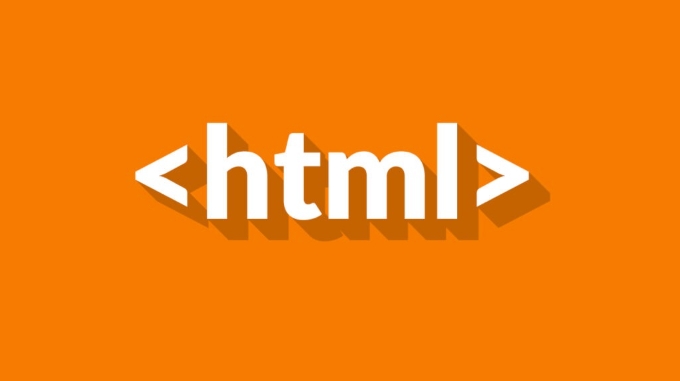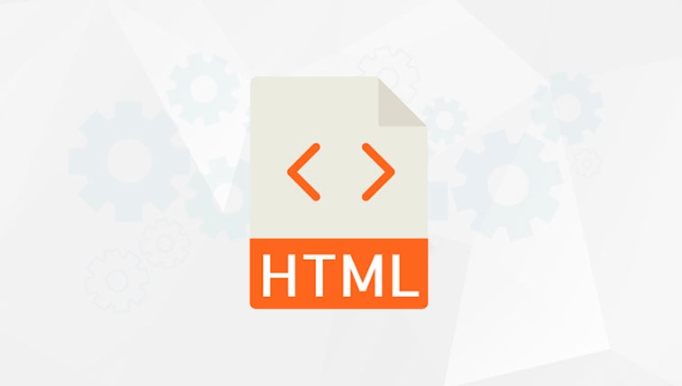Common HTML event properties include onload, onchange, onsubmit, onmouseout, onkeydown and onkeyup; onclick is used to respond to click behavior, and it is recommended to interact through function calls or JS binding; onmouseover and onmouseout are often used for hovering effects; it is recommended to use addEventListener to implement event binding for maintenance and extension.

In web development, HTML event attributes such as onclick and onmouseover are the key to making the page "live". They allow us to trigger JavaScript code when the user performs certain operations, thus enabling interactive functions.

What are the common HTML event properties?
In addition to onclick and onmouseover mentioned in the title, there are some commonly used event properties:
-
onload: Triggered after the page or element is loaded -
onchange: Triggered after the content of the form element is changed (such as<input>or<select></select>) -
onsubmit: fired when form is submitted -
onmouseout: Triggered when the mouse moves out the element -
onkeydown/onkeyup: Triggered when the keyboard key is pressed or released
These event properties can be written directly in HTML tags, for example:

<button onclick="alert('clicked on the button')">Click me</button>
However, although this writing method is convenient, it is not conducive to maintenance. It is usually recommended to separate JS logic.
How to correctly use onclick to achieve click interaction?
onclick is the most commonly used event attribute, used to respond to user click behavior. You can use it to call a function, or execute a piece of code directly.

For example:
<button onclick="showMessage()">Show information</button>
<script>
function showMessage() {
alert("You clicked the button!");
}
</script>Some practical suggestions:
- Try not to write large pieces of JS logic in HTML, but call functions
- You can bind the same function to multiple elements to improve code reusability
- Be careful to avoid duplicate IDs, otherwise the event binding may be invalid.
In addition, events can also be bound through JS, which is more flexible:
document.getElementById("myButton").addEventListener("click", function () {
alert("button was clicked");
}); What can onmouseover and onmouseout do?
These two events are often used to achieve "hover effect", such as changing the style when the mouse moves to an element, popping up prompts, etc.
To give a simple example:
<div onmouseover="this.style.backgroundColor='yellow'" onmouseout="this.style.backgroundColor=''"> Put the mouse on and try it</div>
This code implements the background turns yellow when the mouse hovers over the div and recovers after leaving.
Use scenarios include:
- Display of floating menus or tooltips
- Dynamically change styles and enhance interactive experience
- Mouse sensing effect in the game
However, it should be noted that excessive use may cause interference to the user, so you should control the frequency and effect moderately.
Why is it recommended to use JS to listen for events instead of HTML attributes?
Although it is convenient to write onclick and other attributes directly in HTML, from the perspective of project maintenance and extension, it is still more recommended to use JavaScript's addEventListener method to bind events.
Advantages include:
- Multiple listeners can be added to the same event
- Easier to unbind events (using
removeEventListener) - Better organize code structures for easy debugging and maintenance
For example:
const btn = document.getElementById("myBtn");
btn.addEventListener("click", function () {
console.log("button was clicked");
});Moreover, this method is easier to make complex logic such as conditional judgment and loop binding.
Basically that's it. These event attributes are not complicated, but they are very practical in actual development. As long as you pay attention to the reasonable use method, you can achieve good interaction effects.
The above is the detailed content of HTML Event Attributes: `onclick`, `onmouseover`, etc.. For more information, please follow other related articles on the PHP Chinese website!

Hot AI Tools

Undress AI Tool
Undress images for free

Undresser.AI Undress
AI-powered app for creating realistic nude photos

AI Clothes Remover
Online AI tool for removing clothes from photos.

Clothoff.io
AI clothes remover

Video Face Swap
Swap faces in any video effortlessly with our completely free AI face swap tool!

Hot Article

Hot Tools

Notepad++7.3.1
Easy-to-use and free code editor

SublimeText3 Chinese version
Chinese version, very easy to use

Zend Studio 13.0.1
Powerful PHP integrated development environment

Dreamweaver CS6
Visual web development tools

SublimeText3 Mac version
God-level code editing software (SublimeText3)
 Applying Semantic Structure with article, section, and aside in HTML
Jul 05, 2025 am 02:03 AM
Applying Semantic Structure with article, section, and aside in HTML
Jul 05, 2025 am 02:03 AM
The rational use of semantic tags in HTML can improve page structure clarity, accessibility and SEO effects. 1. Used for independent content blocks, such as blog posts or comments, it must be self-contained; 2. Used for classification related content, usually including titles, and is suitable for different modules of the page; 3. Used for auxiliary information related to the main content but not core, such as sidebar recommendations or author profiles. In actual development, labels should be combined and other, avoid excessive nesting, keep the structure simple, and verify the rationality of the structure through developer tools.
 Implementing Clickable Buttons Using the HTML button Element
Jul 07, 2025 am 02:31 AM
Implementing Clickable Buttons Using the HTML button Element
Jul 07, 2025 am 02:31 AM
To use HTML button elements to achieve clickable buttons, you must first master its basic usage and common precautions. 1. Create buttons with tags and define behaviors through type attributes (such as button, submit, reset), which is submitted by default; 2. Add interactive functions through JavaScript, which can be written inline or bind event listeners through ID to improve maintenance; 3. Use CSS to customize styles, including background color, border, rounded corners and hover/active status effects to enhance user experience; 4. Pay attention to common problems: make sure that the disabled attribute is not enabled, JS events are correctly bound, layout occlusion, and use the help of developer tools to troubleshoot exceptions. Master this
 Configuring Document Metadata Within the HTML head Element
Jul 09, 2025 am 02:30 AM
Configuring Document Metadata Within the HTML head Element
Jul 09, 2025 am 02:30 AM
Metadata in HTMLhead is crucial for SEO, social sharing, and browser behavior. 1. Set the page title and description, use and keep it concise and unique; 2. Add OpenGraph and Twitter card information to optimize social sharing effects, pay attention to the image size and use debugging tools to test; 3. Define the character set and viewport settings to ensure multi-language support is adapted to the mobile terminal; 4. Optional tags such as author copyright, robots control and canonical prevent duplicate content should also be configured reasonably.
 Best HTML tutorial for beginners in 2025
Jul 08, 2025 am 12:25 AM
Best HTML tutorial for beginners in 2025
Jul 08, 2025 am 12:25 AM
TolearnHTMLin2025,chooseatutorialthatbalanceshands-onpracticewithmodernstandardsandintegratesCSSandJavaScriptbasics.1.Prioritizehands-onlearningwithstep-by-stepprojectslikebuildingapersonalprofileorbloglayout.2.EnsureitcoversmodernHTMLelementssuchas,
 HTML for email templates tutorial
Jul 10, 2025 pm 02:01 PM
HTML for email templates tutorial
Jul 10, 2025 pm 02:01 PM
How to make HTML mail templates with good compatibility? First, you need to build a structure with tables to avoid using div flex or grid layout; secondly, all styles must be inlined and cannot rely on external CSS; then the picture should be added with alt description and use a public URL, and the buttons should be simulated with a table or td with background color; finally, you must test and adjust the details on multiple clients.
 How to associate captions with images or media using the html figure and figcaption elements?
Jul 07, 2025 am 02:30 AM
How to associate captions with images or media using the html figure and figcaption elements?
Jul 07, 2025 am 02:30 AM
Using HTML sums allows for intuitive and semantic clarity to add caption text to images or media. 1. Used to wrap independent media content, such as pictures, videos or code blocks; 2. It is placed as its explanatory text, and can be located above or below the media; 3. They not only improve the clarity of the page structure, but also enhance accessibility and SEO effect; 4. When using it, you should pay attention to avoid abuse, and apply to content that needs to be emphasized and accompanied by description, rather than ordinary decorative pictures; 5. The alt attribute that cannot be ignored, which is different from figcaption; 6. The figcaption is flexible and can be placed at the top or bottom of the figure as needed. Using these two tags correctly helps to build semantic and easy to understand web content.
 What are the most commonly used global attributes in html?
Jul 10, 2025 am 10:58 AM
What are the most commonly used global attributes in html?
Jul 10, 2025 am 10:58 AM
class, id, style, data-, and title are the most commonly used global attributes in HTML. class is used to specify one or more class names to facilitate style setting and JavaScript operations; id provides unique identifiers for elements, suitable for anchor jumps and JavaScript control; style allows for inline styles to be added, suitable for temporary debugging but not recommended for large-scale use; data-properties are used to store custom data, which is convenient for front-end and back-end interaction; title is used to add mouseover prompts, but its style and behavior are limited by the browser. Reasonable selection of these attributes can improve development efficiency and user experience.
 How to handle forms submission in HTML without a server?
Jul 09, 2025 am 01:14 AM
How to handle forms submission in HTML without a server?
Jul 09, 2025 am 01:14 AM
When there is no backend server, HTML form submission can still be processed through front-end technology or third-party services. Specific methods include: 1. Use JavaScript to intercept form submissions to achieve input verification and user feedback, but the data will not be persisted; 2. Use third-party serverless form services such as Formspree to collect data and provide email notification and redirection functions; 3. Use localStorage to store temporary client data, which is suitable for saving user preferences or managing single-page application status, but is not suitable for long-term storage of sensitive information.






